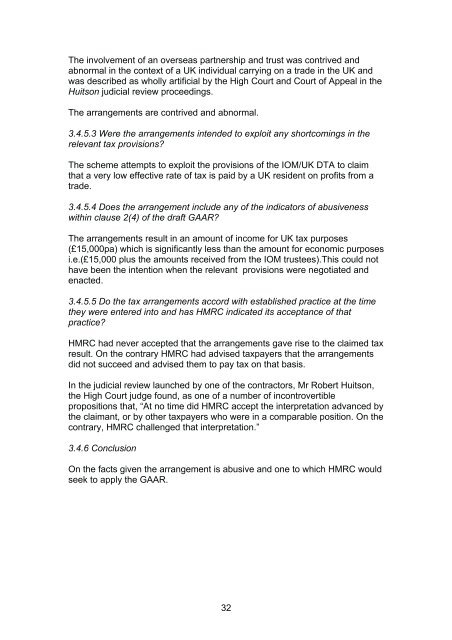Examples of how the GAAR applies to tax arrangements
Examples of how the GAAR applies to tax arrangements
Examples of how the GAAR applies to tax arrangements
You also want an ePaper? Increase the reach of your titles
YUMPU automatically turns print PDFs into web optimized ePapers that Google loves.
The involvement <strong>of</strong> an overseas partnership and trust was contrived and<br />
abnormal in <strong>the</strong> context <strong>of</strong> a UK individual carrying on a trade in <strong>the</strong> UK and<br />
was described as wholly artificial by <strong>the</strong> High Court and Court <strong>of</strong> Appeal in <strong>the</strong><br />
Huitson judicial review proceedings.<br />
The <strong>arrangements</strong> are contrived and abnormal.<br />
3.4.5.3 Were <strong>the</strong> <strong>arrangements</strong> intended <strong>to</strong> exploit any shortcomings in <strong>the</strong><br />
relevant <strong>tax</strong> provisions?<br />
The scheme attempts <strong>to</strong> exploit <strong>the</strong> provisions <strong>of</strong> <strong>the</strong> IOM/UK DTA <strong>to</strong> claim<br />
that a very low effective rate <strong>of</strong> <strong>tax</strong> is paid by a UK resident on pr<strong>of</strong>its from a<br />
trade.<br />
3.4.5.4 Does <strong>the</strong> arrangement include any <strong>of</strong> <strong>the</strong> indica<strong>to</strong>rs <strong>of</strong> abusiveness<br />
within clause 2(4) <strong>of</strong> <strong>the</strong> draft <strong>GAAR</strong>?<br />
The <strong>arrangements</strong> result in an amount <strong>of</strong> income for UK <strong>tax</strong> purposes<br />
(£15,000pa) which is significantly less than <strong>the</strong> amount for economic purposes<br />
i.e.(£15,000 plus <strong>the</strong> amounts received from <strong>the</strong> IOM trustees).This could not<br />
have been <strong>the</strong> intention when <strong>the</strong> relevant provisions were negotiated and<br />
enacted.<br />
3.4.5.5 Do <strong>the</strong> <strong>tax</strong> <strong>arrangements</strong> accord with established practice at <strong>the</strong> time<br />
<strong>the</strong>y were entered in<strong>to</strong> and has HMRC indicated its acceptance <strong>of</strong> that<br />
practice?<br />
HMRC had never accepted that <strong>the</strong> <strong>arrangements</strong> gave rise <strong>to</strong> <strong>the</strong> claimed <strong>tax</strong><br />
result. On <strong>the</strong> contrary HMRC had advised <strong>tax</strong>payers that <strong>the</strong> <strong>arrangements</strong><br />
did not succeed and advised <strong>the</strong>m <strong>to</strong> pay <strong>tax</strong> on that basis.<br />
In <strong>the</strong> judicial review launched by one <strong>of</strong> <strong>the</strong> contrac<strong>to</strong>rs, Mr Robert Huitson,<br />
<strong>the</strong> High Court judge found, as one <strong>of</strong> a number <strong>of</strong> incontrovertible<br />
propositions that, “At no time did HMRC accept <strong>the</strong> interpretation advanced by<br />
<strong>the</strong> claimant, or by o<strong>the</strong>r <strong>tax</strong>payers who were in a comparable position. On <strong>the</strong><br />
contrary, HMRC challenged that interpretation.”<br />
3.4.6 Conclusion<br />
On <strong>the</strong> facts given <strong>the</strong> arrangement is abusive and one <strong>to</strong> which HMRC would<br />
seek <strong>to</strong> apply <strong>the</strong> <strong>GAAR</strong>.<br />
32

















